Although stakeholder management isn’t the most glamorous part of the product management practice, it is one of its most critical components.
Contrary to popular belief, the PM is not the “CEO of the product.” They can’t just do whatever they want. More often than not, a PM needs buy-in from key players to get their initiatives moving.
In this article, we’ll dig deeper into the topic of stakeholder management.
Table of contents
- What is stakeholder management and why do we need it?
- How to implement proper stakeholder management
What is stakeholder management and why do we need it?
I like to define stakeholder management as a “continuous process of getting support for initiatives while building healthy relationships and gaining influence.”
Let’s examine this definition step by step:
- A continuous process: stakeholder management isn’t something you do once in a while. It happens all the time. Even if you decide to lock yourself in a basement and ignore all your calls, it still impacts your relationship with key players. Every action you take leaves a mark, one way or another
- Of getting support for initiatives: for most of our initiatives, we need buy-in from key players. Whether securing resources, managing dependencies, or getting the proper approvals, you won’t go far without buy-in
- While building healthy relationships: relationships are key. Not only is it easier to get support when people like you, but the work is simply more enjoyable if you have a healthy relationship with those around you
- And gaining influence: over time, you want to gain the trust and respect of your colleagues. It will make getting further buy-in easier
Since a product manager usually needs other people’s buy-in and is often expected to lead through influence, stakeholder management should be at the top of your priority list.
Great stakeholder management leads to resources, support, and even friendships. Poor stakeholder management might be a nail in the coffin of one’s career.
How to implement proper stakeholder management
The general idea of stakeholder management is relatively straightforward. Keep people around you happy and on your side.
In smaller setups — when you have a handful of stakeholders to manage — you don’t really need any tools or specific strategies. Make sure to spend time with stakeholders, understand their needs, and maintain a healthy relationship with them. After that, you should be good to go.
It’s a different story when you have dozens of stakeholders on your radar or when you lead multiple initiatives with different sets of stakeholders. You need a more organized system to manage stakeholders in cases like that.
In the following section, we’ll go over how to identify types of stakeholders and how to identify the relationships between stakeholders. There are a few useful tools for managing stakeholders in a more complex setting, and we’ll go over them as well.
Identifying types of stakeholders
The first step in successful stakeholder management is identifying the types of stakeholders within your organization or project. You can do this in several ways, let’s jump into it.
Influence x interest matrix
The influence x interest matrix segments stakeholders into four buckets:
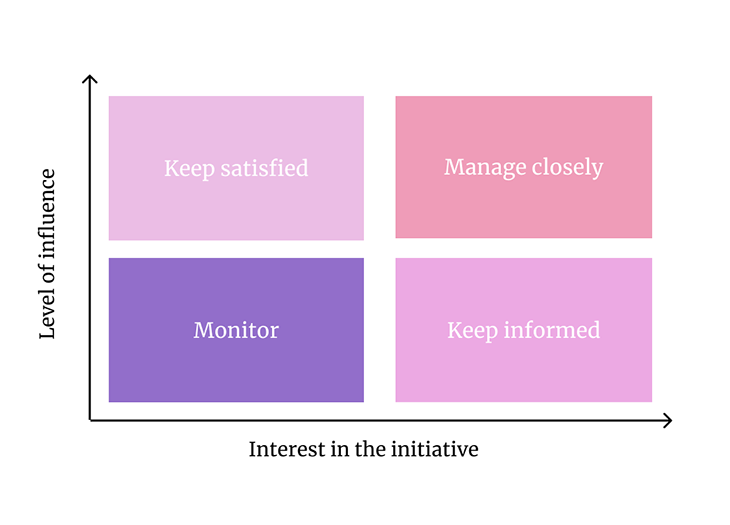
In general, stakeholders can be placed within the four quadrants shown on the map above.
- High interest and high influence: these are the key players in a given initiative and should be proactively managed and consulted. Their opinion can make or break the whole project
- High interest and low influence: although they have little influence, you can score additional points by satisfying their curiosity and keeping them informed
- Low interest and high influence: it’s crucial to keep influential stakeholders satisfied. Even though they might not be interested in the initiative right now, if for some reason they become dissatisfied with its direction, they’ll quickly get interested
- Low interest and low influence: people with no interest nor influence can be ignored. However, it’s worth reviewing them once in a while, as interest and influence might change over time
While the influence x interest matrix is an excellent tool for stakeholder management, I find it slightly too excessive for most initiatives. I use a simplified version that distinguishes only two types of stakeholders:
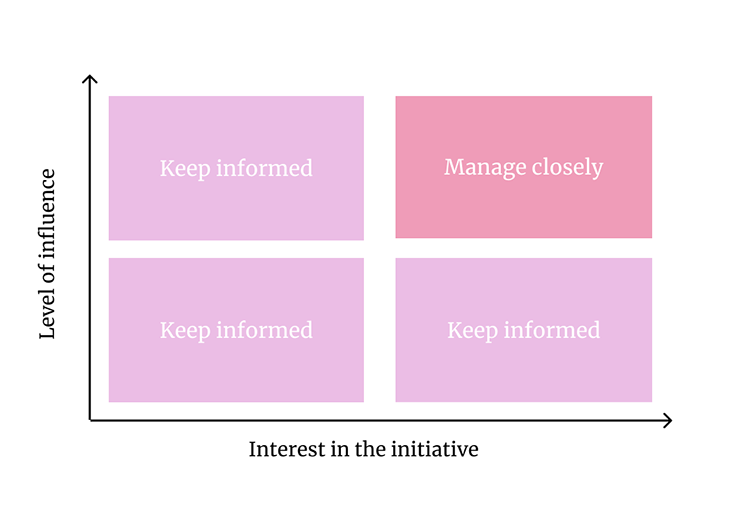
Although the simplification brings some additional risks, over time, I learned that managing key players closely is 80 percent of the success of stakeholder management.
Regardless if you use the full version or a simplified one, make sure to update it regularly. Stakeholders’ levels of influence and interest change all the time. A distant stakeholder today might become your key player tomorrow.
Support bubble chart
You don’t only want to know how vital given stakeholders are, but also be able to group them based on their opinions regarding the initiative.
In most cases, you will have three types of stakeholders:
- Supporters: people who love the initiative, benefit from it, and will help you succeed
- Opposers: people who, for some reason, don’t like the initiative and don’t want it to succeed
- Neutrals: people that don’t have any specific opinion.
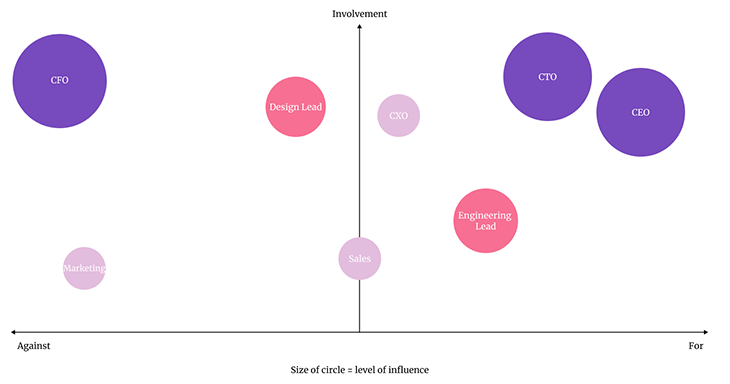
A bubble chart works great because it shows not only the given stakeholder’s opinion on the initiative (left-light alignment) but also their level of involvement (top-bottom alignment) and influence (bubble size).
Maximize the help you get from your top supporters, try to mitigate risks posed by top negators, and try to sway neutrals your way to maximize the chances of initiative success.
Understanding stakeholders’ relationships between themselves and the product
After you identify the types of stakeholders, it’s also important to see how these groups and individuals interact with the project, as well as with each other.
RACI matrix
The responsibility assignment matrix, or RACI matrix, describes the relations of different stakeholders within a given initiative:
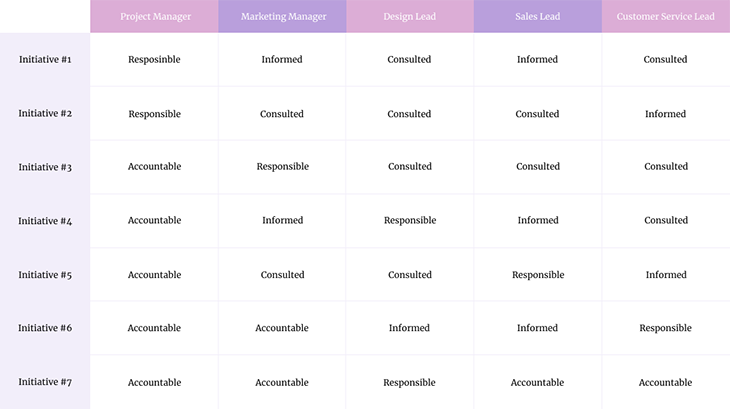
It distinguishes four types of relationships:
- Responsible: this stakeholder is responsible for successfully finishing a given task or initiative. There’s always at least one responsible person, but more people may be responsible for more complex initiatives
- Accountable: the one ultimately accountable for the success of the initiative. In some cases, an accountable stakeholder is the one giving feedback and the final green light
- Consulted: these stakeholders either have invaluable subject matter expertise or are heavily impacted by a given initiative. You should consider their opinion when making decisions
- Informed: these people either don’t have or don’t want to have a say in a given project. However, for some reason, they should be kept in the loop — for example, because their initiatives depend on yours
The RACI matrix works excellently as a transparency tool. If you keep it public, all stakeholders will see who does what for a project. It also works as a guardrail — you can always double-check if you have consulted all essential parties and if the information reaches all critical stakeholders.
You can use the RACI matrix to keep track of stakeholders whenever you have numerous expectations to manage.
Stakeholder map
The purpose of a stakeholder map is to identify relationships between stakeholders. After all, they don’t live in silos.
Different stakeholders have different levels of influence on other stakeholders. Sometimes, if you need the support of five other stakeholders, it might be easier to win the buy-in of their boss and then ask him to influence the rest.
Conversely, enraging one key player might lead to losing the support of half of the stakeholders. Some stakeholders impact others:
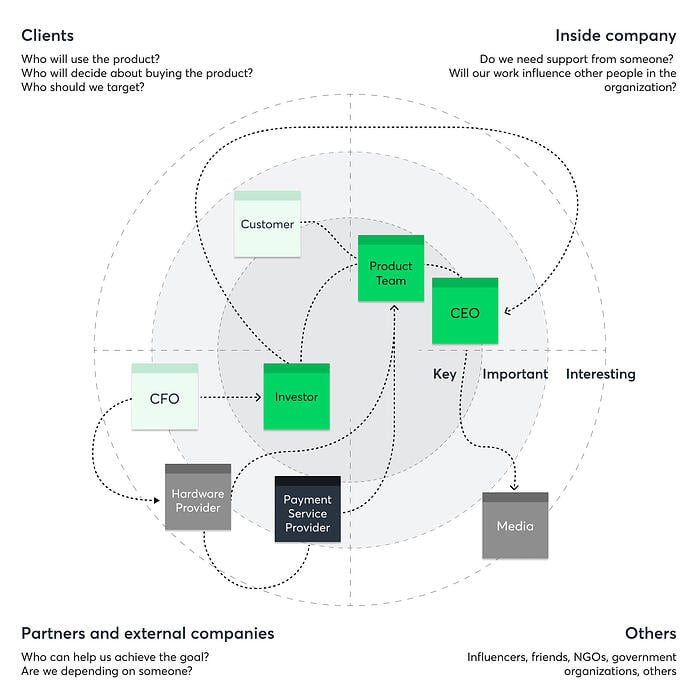
Map your most important stakeholders and their relation to other stakeholders. This will help you spot those few with the highest leverage and focus on them.
Even if you need buy-in from 100 people, sometimes all you need is to win a few of them; the rest will follow along.
Mix up your stakeholder management tools
This is a partial list of all stakeholder management tools, it’s by no means exhaustive. In the same vein, none of these tools is better than the others. Each tool serves a different purpose:
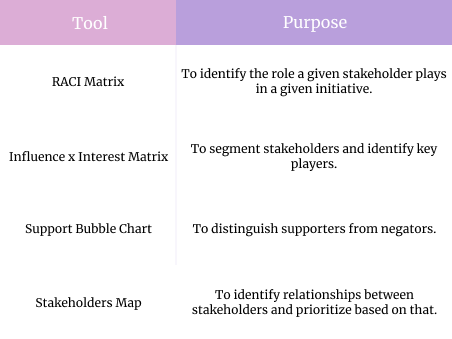
Depending on how precise you need your stakeholder management practice, you might want to use all of these tools simultaneously — each for different purposes — or none at all.
Conclusion
Stakeholder management is the bread and butter of product management practice. It leads to buy-in, and buy-in brings resources and support. To some extent, having stakeholder support is like fuel for a product manager. The more you have, the farther you can go.
Whether you decide to use a suite of complex tools and systems for managing stakeholders or just follow your gut feeling, always keep stakeholders in the back of your head.
Their support can make or break the whole initiative.
The post What is stakeholder management: Tools and techniques appeared first on LogRocket Blog.
from LogRocket Blog https://ift.tt/L4VSfIv
Gain $200 in a week
via Read more



